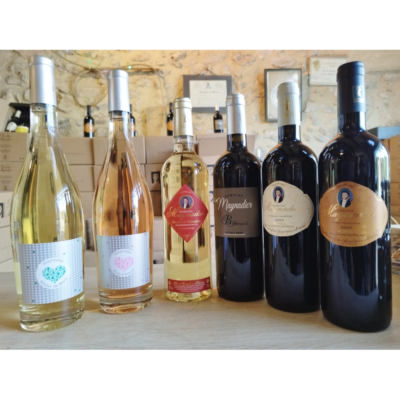The wine that is now called Vin de France was previously labelled “Vin de table“. This is the new category of wines without geographical indication, SIG.
Definition of “Vin de France”
Since 1 August 2009, the appellation “Vin de France” has replaced the category “Vin de table”. Vin de France is considered to be at the very bottom of the ladder compared to the other designations. This does not mean that it is a poor quality wine, but given its huge diversity and the great freedom producers have in making it, it cannot be judged solely on this designation.
The wines of France are made by blending wines from different origins, regions or vintages.
There are, however, a few rules that must be respected:
- If the producer wishes to indicate a vintage on the label, 85% of the grapes that make up the wine must have been harvested in the corresponding year.
- The same rule applies to the indication of grape varieties.
- Producers are allowed to blend several grape varieties, however, certain varieties are excluded: gewurztraminer, sylvaner, riesling, mondeuse, jacquère, altesse, gringet, persan, savagnin, poulsard and trousseau.
French wines are mostly packaged and sold under a brand name that facilitates their identification. They are marketed by regional operators but also by national operators.
The best known national brands are the following: Les Grands Chais de France (Grand Sud, JP Chenet…) or the Castel Group (Cambras, Vieux Papes, La Villageoise, Champlure…).
For the consumer, national or regional brands are an indication to find a wine with a consistent taste.

The exceptions among “Vins de France”
Some French wines enjoy an extraordinary reputation. If they prefer to keep a SIG label, it is more in rebellion against the demands of certain appellations than for their presumed lack of quality. On the contrary, some French wines shine on French tables as well as abroad.
One example is the French wine Lafite du Languedoc, also known as Daumas Gassac, which was marketed beyond our borders and became the most expensive table wine in the world in 1978.
New accreditation procedures
Under the new EU scheme, if the label does not mention the grape variety or the vintage, the wine does not need any approval procedure to be qualified as a SIG wine.
On the other hand, for everything that concerns labels mentioning the grape variety or the vintage, an authorisation procedure has been compulsory since 2009.
This authorisation is issued by the services of FranceAgriMer, which organises the control plan leading to the traceability of these wines.

Mandatory information on the label
To obtain the ad hoc authorisation, the label of the bottle of Vin de France must include the following information
- the words Vin de France
- the volume and batch number on the packaging
- the actual alcoholic strength by volume
- the name and address of the bottler accompanied by the words “bottler” or “bottled by” and, in the case of imported wines, the identity of the importer
- the allergenic ingredients (the mention of sulphites is the only compulsory one to date) as well as the health message “the consumption of alcoholic beverages during pregnancy, even in small quantities, can have serious consequences on the health of the child” or the corresponding logo
- certain optional information such as the vintage year, the name of one or more grape varieties, the sugar content on the label of still wines (dry, semi-dry, sweet)
- for freshly vinified SIG wines, only the word “Nouveau” may appear on the label. The traditional term “Primeur” is reserved for AOP/AOC and IGP wines.

The undeniable success of French wine is still on the rise
The creation of the Wines of France segment with the mention of the grape variety and the vintage in 2009 has boosted the sale of Wines of France.
According to figures from ANIVIN – the National Interprofessional Association of French Wines – in 2010/2011, French wines specifying the grape variety have increased by 135%, bringing the quantity sold to 705,000 hl. For the foreign market, the trade in French wines has also seen a spectacular increase of 25%.
Internationally, French wines are mainly sold in Europe, which accounts for 80% of sales, with Germany in the lead. China has recently become one of our excellent customers. After the AOCs, which represent 45% of exported volumes, then the PGIs at 33%, French wines account for 22%.



